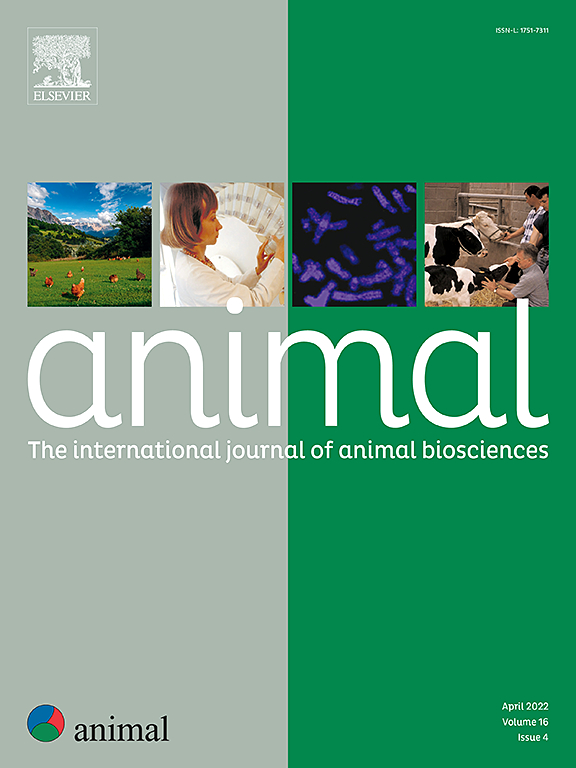Steering protein fermentation by adding fibres in pig diets
IF 4.2
2区 农林科学
Q1 AGRICULTURE, DAIRY & ANIMAL SCIENCE
引用次数: 0
Abstract
Protein fermentation is associated with diarrhoea in pigs through the presence of potentially toxic metabolites, including ammonia, branched−chain fatty acids, biogenic amines, and indolic and phenolic compounds. One approach to reduce these metabolites is the dietary inclusion of fibres. In this experiment, 128 boars (mean BW ± SEM; 24 ± 1.5 kg) were assigned to diets without added fermentable fibres (NFF), with rapidly fermentable fibres (RFF), or with slowly fermentable fibres (SFF), using either bovine collagen (BC) or zein (ZE) as the only, low-digestible protein source. In addition, two control groups received easily digestible whey protein isolate (WPI) either with NFF or SFF. After 2 weeks, digesta contents from the ileum, cecum, proximal- and distal colon were analysed to assess protein digestibility, digesta mean retention time, and the concentrations and flows of protein-derived metabolites. Metabolite flow was used as a proxy for the extent of protein fermentation, reflecting the net appearance of metabolites, while the concentrations provided insight into the direct exposure of the intestinal epithelium to these metabolites. Metabolite flow was generally linked to the precursor amino acid profiles of the protein sources. Apparent ileal protein digestibility did not differ significantly between BC and ZE, except when RFF were added (Fibre × Protein < 0.05), where it was lower in ZE-fed pigs (P < 0.05). Both fibre treatments, but particularly SFF, reduced the concentrations of most protein-derived metabolites. The effects of RFF and SFF on colonic metabolite flows varied depending on metabolite type and protein source. In the proximal colon of ZE-fed pigs, dietary fibres reduced the flows of branched−chain fatty acids (BCFA; RFF: 26%, SFF: 33%), indole (RFF: 70%, SFF: 59%), and p-cresol (SFF: 28%), while no effects were observed in BC-fed pigs (Fibre × Protein < 0.05). No fibre effects on the flows of ammonia, biogenic amines, valeric acid, phenol, and skatole were observed in either BC- or ZE-fed pigs. In WPI-fed pigs, SFF significantly increased the flows of BCFA (47%), p-cresol (75%), and biogenic amines (120%; all P < 0.05) in the proximal colon. It can be concluded that protein fermentation primarily occurs in the proximal colon, starting in the ileum, with metabolite production generally linked to amino acid precursor composition. While dietary fibres reduced the concentrations of most protein-derived metabolites, the ability of different fibres to steer the extent of protein fermentation is strongly dependent on the source of proteins being fermented.
通过在猪日粮中添加纤维来指导蛋白质发酵
蛋白质发酵与猪腹泻有关,因为存在潜在毒性代谢物,包括氨、支链脂肪酸、生物胺以及吲哚和酚类化合物。减少这些代谢物的一种方法是在饮食中加入纤维。试验选取128头公猪(平均体重±SEM; 24±1.5 kg),分别饲喂不添加可发酵纤维(NFF)、添加快速发酵纤维(RFF)和添加慢发酵纤维(SFF)的饲粮,以牛胶原蛋白(BC)或玉米蛋白(ZE)作为唯一的低消化蛋白质来源。另外,两个对照组分别给予易消化乳清分离蛋白(WPI)和NFF或SFF。2周后,分析回肠、盲肠、结肠近端和远端食糜内容物,以评估蛋白质消化率、食糜平均滞留时间以及蛋白质衍生代谢物的浓度和流量。代谢物流量被用作蛋白质发酵程度的代表,反映了代谢物的净外观,而浓度提供了对肠上皮直接暴露于这些代谢物的洞察。代谢产物流动通常与蛋白质来源的前体氨基酸谱有关。除添加RFF(纤维×蛋白质<; 0.05)组外,添加RFF的猪回肠蛋白质表观消化率低于添加RFF的猪(P < 0.05)。两种纤维处理,尤其是SFF处理,都降低了大多数蛋白质衍生代谢物的浓度。RFF和SFF对结肠代谢物流量的影响因代谢物类型和蛋白质来源而异。在ze饲猪的近端结肠中,日粮纤维减少了支链脂肪酸(BCFA; RFF: 26%, SFF: 33%)、吲哚(RFF: 70%, SFF: 59%)和对甲酚(SFF: 28%)的流量,而bc饲猪则没有影响(纤维×蛋白<; 0.05)。在BC和ze饲猪中,未观察到纤维对氨、生物胺、戊酸、苯酚和粪臭素的流动有影响。在wpi喂养的猪中,SFF显著增加了BCFA(47%)、对甲酚(75%)和生物胺(120%,均P <; 0.05)在近端结肠的流量。由此可见,蛋白质发酵主要发生在结肠近端,从回肠开始,代谢产物的产生通常与氨基酸前体组成有关。虽然膳食纤维降低了大多数蛋白质衍生代谢物的浓度,但不同纤维控制蛋白质发酵程度的能力在很大程度上取决于发酵蛋白质的来源。
本文章由计算机程序翻译,如有差异,请以英文原文为准。
求助全文
约1分钟内获得全文
求助全文
来源期刊

Animal
农林科学-奶制品与动物科学
CiteScore
7.50
自引率
2.80%
发文量
246
审稿时长
3 months
期刊介绍:
Editorial board
animal attracts the best research in animal biology and animal systems from across the spectrum of the agricultural, biomedical, and environmental sciences. It is the central element in an exciting collaboration between the British Society of Animal Science (BSAS), Institut National de la Recherche Agronomique (INRA) and the European Federation of Animal Science (EAAP) and represents a merging of three scientific journals: Animal Science; Animal Research; Reproduction, Nutrition, Development. animal publishes original cutting-edge research, ''hot'' topics and horizon-scanning reviews on animal-related aspects of the life sciences at the molecular, cellular, organ, whole animal and production system levels. The main subject areas include: breeding and genetics; nutrition; physiology and functional biology of systems; behaviour, health and welfare; farming systems, environmental impact and climate change; product quality, human health and well-being. Animal models and papers dealing with the integration of research between these topics and their impact on the environment and people are particularly welcome.
 求助内容:
求助内容: 应助结果提醒方式:
应助结果提醒方式:


